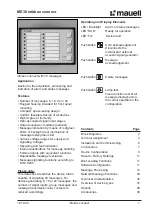
ADC Power Up Delay
ADC Ready for Conversions
PWDNBG
PWDNREF
PWDNADC
Request for
ADC Conversion
t
d(BGR)
t
d(PWD)
TMS320F2810, TMS320F2811, TMS320F2812
TMS320C2810, TMS320C2811, TMS320C2812
SPRS174T – APRIL 2001 – REVISED MAY 2012
www.ti.com
6.30.4 ADC Power-Up Control Bit Timing
Figure 6-40. ADC Power-Up Control Bit Timing
Table 6-47. ADC Power-Up Delays
(1)
MIN
TYP
MAX
UNIT
Delay time for band gap reference to be stable. Bits 7 and 6 of the ADCTRL3
t
d(BGR)
register (ADCBGRFDN1/0) are to be set to 1 before the ADCPWDN bit is
7
8
10
ms
enabled.
20
50
µs
Delay time for power-down control to be stable. Bit 5 of the ADCTRL3 register
t
d(PWD)
(ADCPWDN) is to be set to 1 before any ADC conversions are initiated.
1
ms
(1)
These delays are necessary and recommended to make the ADC analog reference circuit stable before conversions are initiated. If
conversions are started without these delays, the ADC results will show a higher gain. For power down, all three bits can be cleared at
the same time.
6.30.5 Detailed Description
6.30.5.1 Reference Voltage
The on-chip ADC has a built-in reference, which provides the reference voltages for the ADC. ADCVREFP
is set to 2.0 V and ADCVREFM is set to 1.0 V.
6.30.5.2 Analog Inputs
The on-chip ADC consists of 16 analog inputs, which are sampled either one at a time or two channels at
a time. These inputs are software-selectable.
6.30.5.3 Converter
The on-chip ADC uses a 12-bit four-stage pipeline architecture, which achieves a high sample rate with
low power consumption.
6.30.5.4 Conversion Modes
The conversion can be performed in two different conversion modes:
•
Sequential sampling mode (SMODE = 0)
•
Simultaneous sampling mode (SMODE = 1)
146
Electrical Specifications
Copyright © 2001–2012, Texas Instruments Incorporated
Submit Documentation Feedback
Product Folder Link(s):
TMS320F2810 TMS320F2811 TMS320F2812 TMS320C2810 TMS320C2811 TMS320C2812














































